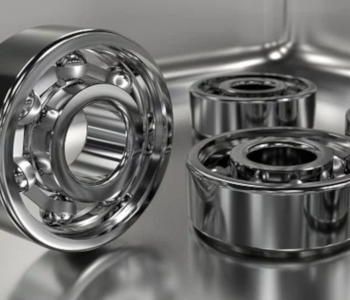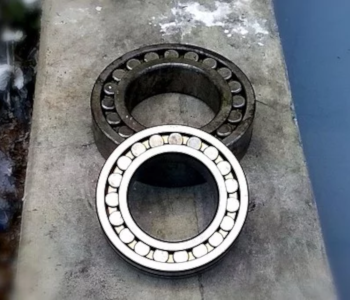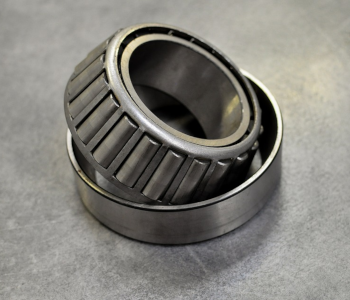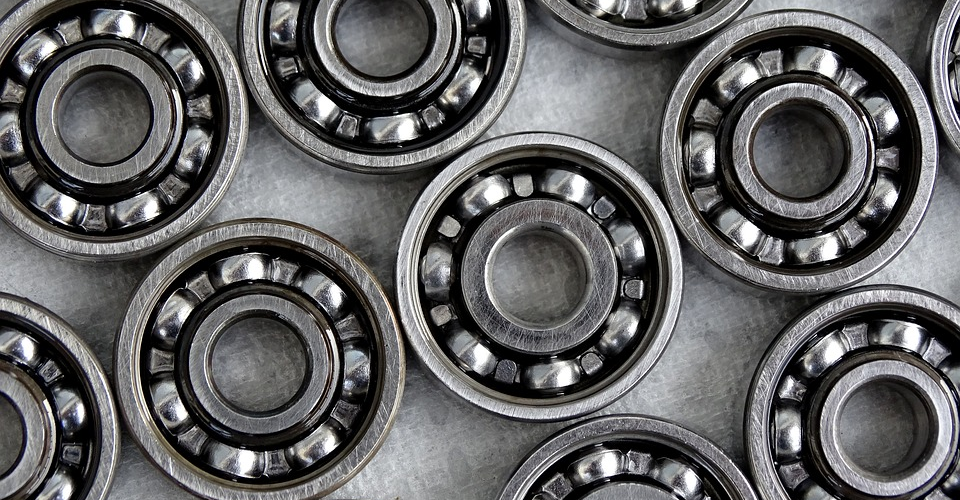Ball Bearings vs Roller Bearings: How Are They Different?
Moving parts, whether in industrial equipment or household appliances, require precision engineering. Not only do the parts need to be reliable, but the connections between them have to allow for unrestricted movement along the axes where movement is required.
One of the methods for allowing smooth movement between separate components is through the use of bearings, of which there are two common types: ball bearings and roller bearings. How do these components work and how are the two types different from each other? When should you pick one over the other?
What are bearings for?

Bearings are internal components between moving parts that are used to reduce friction during motion. By reducing friction, motion between separate parts proceeds smoothly and unimpeded. Bearings also reduce the need for constant lubrication and slow down the usual wear and tear that component parts go through because of constant motion.
To achieve this reduction in friction, bearings need to be able to rotate freely along a specific axis. For this reason, there are two shapes that are used for bearings: balls and rollers. Bearings also provide act as a separating boundary between the two components so that they are never in direct contact with each other, thus reducing both friction and wear and tear. Most bearing assemblies come with a shield or seal that is designed to keep the bearings greased and prevent dust intrusion.
If you have anything in your household that rotates, the chances are that it contains a bearing in some form. Common examples include drawers, fans, and fidget spinners
Bearings are also expected to bear weight, which means they need to satisfy some qualification of durability. Ball bearing and roller bearings behave very differently when it comes to this aspect.
There are two types of loading to remember when talking about bearings: a radial load and a thrust load. A radial load acts parallel to the axis of rotation of a bearing, allowing the bearing to rotate. A thrust load is any load that acts at an angle to the parallel. How the bearing will react to a thrust load depend on the type of bearing.
What is a ball bearing?

A ball bearing consists of hardened spherical balls contained along inner and outer raceways. When subjected to a load, a ball bearing transfers the load from the inner raceway to the outer raceway, thus creating rotational motion.
The main characteristic of a ball bearing is that it has a very small contact area with the load. This contact area is theoretically a point on each side of the ball, although very slight deformations can expand this point of contact.
Ball bearings are far more common than roller bearings because of their simplicity. If you’ve tried opening up a fidget spinner, then you should already know what ball bearings look like. They can also be easily found around the house, such as in drawers, wheels, and hard drives.
PROS
1. Low friction
The main advantage of having a large area of contact is that ball bearings experience much less friction due to the motion of inner and outer raceways. This means that the rotation of the components proceeds very smoothly. Again, we only have to look at fidget spinners to realize how well ball bearings handle rotational motion. Thus, ball bearings are the preferred solution in applications where speed and ease of operations are prioritized.
2. Can handle radial and thrust loads
One other unique property of ball bearings is that they can rotate on more than one axis. This means that they react not just to radial loads, but also to thrust loads. How ball bearings rotate will depend on the angle of the thrust load. The added versatility of ball bearings makes them excellent choices for equipment that aren’t used according to strict standards, such as toys or other items around the house.
CONS
1. Cannot handle large weights
Although the small contact area of ball bearings with loads means that they are subjected to much less pressure, it also means that the loads become more concentrated. In extreme cases, this can lead to the deformation of the ball bearings, which is the precursor to total failure. For this reason, ball bearings are typically only used for applications that have small loads. For industrial-level equipment, roller bearings are more preferred.
A type of ball bearing, called a full-complement ball bearing, fills up the space between the inner and outer raceways with as many balls as possible. By distributing the loads to more balls, this type of bearing can handle higher loads. However, a full-complement ball bearing is also more prone to wear and tear because of more frequent contact between adjacent balls.
What is a roller bearing?

In contrast to the spherical shape of a ball bearing, a roller bearing is composed of cylinders with fixed axes of rotation. There is some variation to the shape of the individual cylinders, with each type suitable to specific applications. In any case, roller bearings provide a much greater surface area than ball bearings -a line as opposed to a point.
Roller bearings are more commonly seen in industrial equipment since they are well-suited to handle heavy loads. Typical examples of roller bearing applications include conveyors, pumps, and turbines.
PROS
1. Designed to bear large loads
The large contact areas that roller bearings provide allow them to carry greater loads without deforming or failing. This makes roller bearings the optimal choice for industrial equipment designed to carry heavy loads or for other applications that have little room for failure.
2. Has more variants based on geometry
As opposed to ball bearings, the geometry of a roller can be varied for different types of operations. The standard cylindrical roller is designed for pure radial loads, providing a greater load capacity by sacrificing the ability to handle any thrust loads.
A needle roller bearing is a slight variation of a cylindrical roller with a much smaller diameter. It is used in applications where there is little radial space. A needle roller also provides a lot of contact area but generates a lot of friction and oscillation because of how rapidly it rotates. Thus, it can only be used in equipment that operate at slow speeds and can accommodate a significant amount of vibration.
Tapered roller bearings are tapered on one end instead of being a straight cylinder throughout. This allows a roller bearing to accommodate a limited amount of thrust load. The ratio of the radial load to thrust load that a tapered roller can handle is determined by the angle of the roller. A maximum of 30 degrees is acceptable, but most tapered rollers have an angle between 10 to 16 degrees.
CONS
1. Limited capacity to handle thrust loads
Although there is an option to use tapered versions, the fact remains that roller bearings are not designed primarily for thrust loads. Thus, the movement that roller bearings allow is much more limited. This reduces the versatility of roller bearings, which explains why they aren’t as easily spotted in household settings.
2. More vulnerable to misalignment
Any type of bearing, whether ball or roller, has a small amount of clearance between the bearing elements and the raceways. This internal clearance allows the bearing elements to move smoothly along the raceway. However, it also makes it possible for the bearing elements to become misaligned from their original position.
Ball bearings are more forgiving when it comes to angular misalignment. Roller bearings, much less so. While a ball bearing can handle a misalignment of up to 0.004 inches, a cylindrical roller bearing might already have difficulty rotating when misaligned by anything more than 0.001 inches. This means that roller bearings need to be designed at a much higher level of precision, making them more difficult and expensive to manufacture.
Which one should you use?
While both ball bearings and roller bearings have their advantages and disadvantages, the key to using them properly is recognizing which applications leverage on each one’s strength.
Use a ball bearing if…
You need greater freedom of movement
By its very design, a ball bearing is designed to rotate when either a radial or thrust load acts on it. This makes ball bearings an excellent choice for items where the input cannot be controlled, such as those that are designed for human use.
You are designing equipment for lighter loads
The small contact area that ball bearings provide has its advantages, but its major drawback is that it concentrates all the load that ball bearings receive. This makes them more prone to failure. If you’re using ball bearings, make sure to limit the load to what the manufacturer prescribes.
You need to operate at greater speeds
The benefit of the small contact area of ball bearings is that they also generate much less friction, making them perfect for operating at high speeds. The low friction means less resistance to the rotation of the spherical elements and reduced wear and tear. If you use your ball bearings properly, they should last a very long time before needing to be replaced.
Use a roller bearing if…
You are designing for heavy load operations
The main characteristic of roller bearings is that they provide a larger area of contact – magnitudes higher than ball bearings. This distributed the load more evenly, allowing roller bearings to handle heavy load operations. They are much less prone to deformation or failure.
You don’t need high-speed operations
The downside of the large contact area is that roller bearings tend to generate a lot of friction. Excessive friction leads to heat generation and accelerate wear and tear, both of which are bad to the upkeep of any equipment. This means that roller bearings are meant to rotate at slower speeds than ball bearings and under highly controlled conditions.
You are willing to spend more for precision-made parts
Roller bearings only rotate along one axis. Any misalignment of a single bearing element means that the element is no longer aligned to the radial direction of the load, which means that it can no longer rotate. This makes the design of roller bearings much more demanding in terms of precision, which also makes them a little more expensive.
Final thoughts
Bearings have been used for decades and are undeniably one of the most essential engineering components, both in industrial, commercial, and home settings. They provide smooth and consistent rotational motion that prevents wear and tear due to friction. Ball bearings and the various flavors of roller bearings are just about all anyone could need to provide movable connections between parts that need to rotate along any axis.

